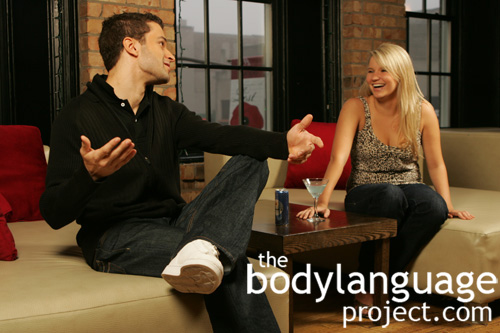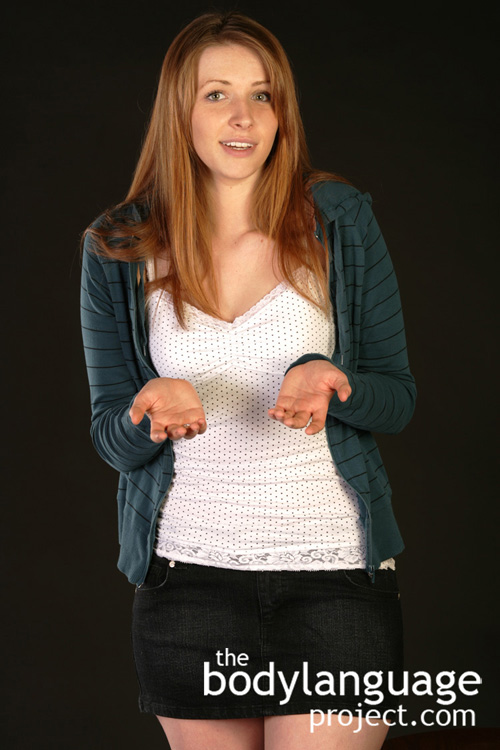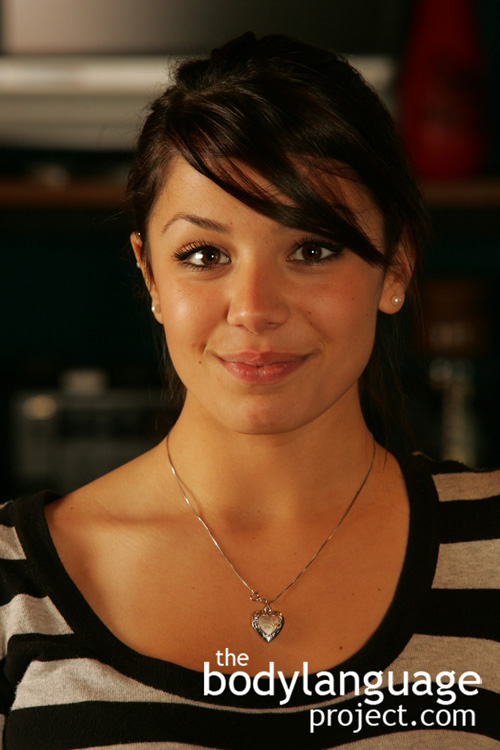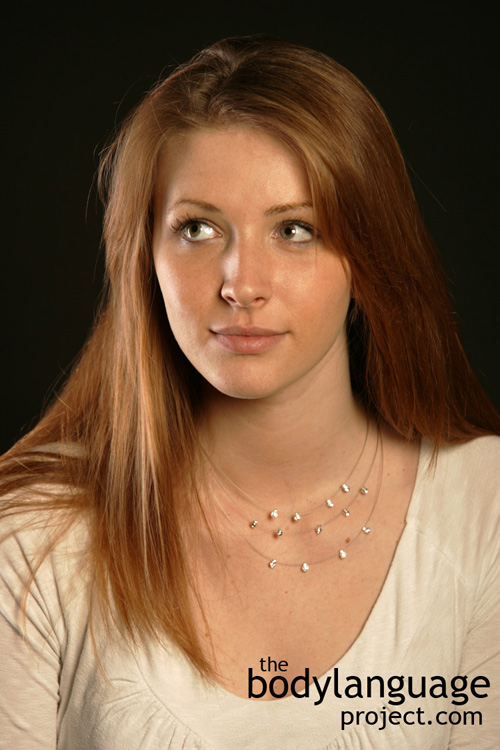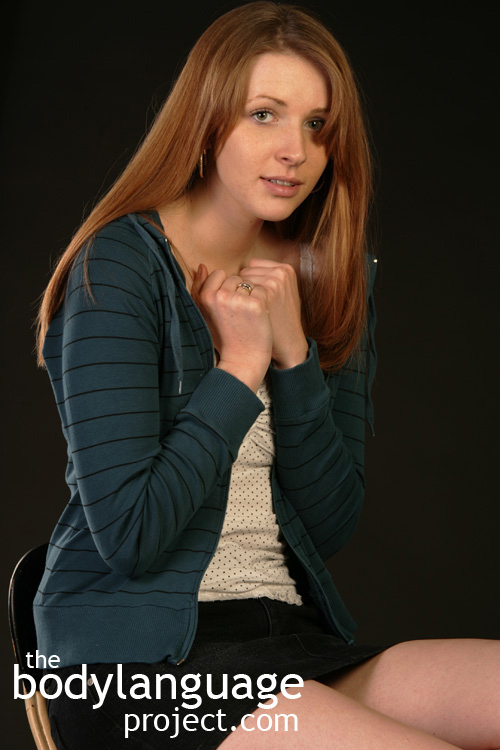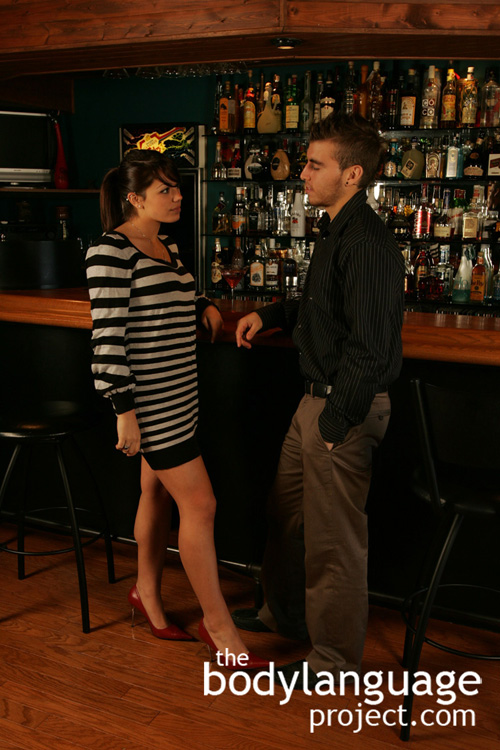Body Language of Wave or Waving
Synonym(s): N/A
Description: The hand is raised and moved back and forth palm facing out.
In One Sentence: Waving is a long distance greeting gesture.
How To Use it: Use the wave to signal “hello” or “goodbye” over a long distance or when vocalizing words is impractical.
Context: General.
Verbal Translation: “I’m flashing my palms over a long distance as a greeting gesture to prove that I carry no weapons and mean no harm.”
Variant: See the various forms of Handshakes.
Cue In Action: a) When approaching the drive on a country walk, his neighbour and he exchanged a wave to say hello. b) While mowing the lawn, Nancy waved to Bill who was claiming his mail from the box.
Meaning and/or Motivation: Waving the hand back and forth is a greeting gesture done over long distance. Compare the wave to a handshake, hug or kiss-hello for example. Waving is appropriate when saying goodbye or hello. Those that live in the country habitually wave rather than shake hands as they are not as accustomed to allowing people into their personal space, as those who reside in the city.
The wave, as a long distance greeting, probably has roots in showing that we aren’t carrying a spear, sword, or bow and arrow. Having the hands deep in a pocket or carried behind the back can be a sign of aggression or passive threat, and our evolutionary history tells us that someone who is hiding something is someone that we shouldn’t trust. While they probably carry no weapon, the hands behind the back produces images other than the hiding a bouquet of flowers.
Showing open palms, facing up, or the “palm flash” is essentially what would have happened thousands of years ago when two foreign tribes met.
Even today we might guess that a stranger approaching us on the street was up to no good especially if they hid their hands at their backs or tucked inside a jacket.
Cue Cluster: A wave has meaning onto itself with no need for supportive cues.
Body Language Category: Greeting gesture, Honest body language, Open body language, Palm power, Rapport or rapport building, Recognition gestures.
Resources:
Axtell, Roger E. Gestures: The Do’s and Taboos of Body Language Around the World. 1997. Wiley.
Andric, Michael ; Solodkin, Ana ; Buccino, Giovanni ; Goldin-Meadow, Susan ; Rizzolatti, Giacomo ; Small, Steven L. Brain function overlaps when people observe emblems, speech, and grasping. Neuropsychologia, 2013, Vol.51(8), pp.1619-1629
Alibali, M.W., Heath, D.C., and Myers,H.J. (2001). Effects of visibility between speaker and listener on gesture production: Some gestures are meant to be seen. Journal of Memory and Language, 44, 169–188.
Beattie, G., & Shovelton,H.(1999). Mapping the range of information contained in the iconich and gestures that accompany spontaneous speech. Journal of Language and social Psychology, 18, 438–462.
Biau, E., & Soto-Faraco, S.(2013). Beat gestures modulate auditory integration in speech perception. Brain and Language, 124(2), 143–152.
Bartolo, A.,Cubelli,R.,DellaSala,S.,&Drei,S.(2003).Pantomimes are special gestures which rely on working memory. Brain and Cognition, 53, 483–494.
Bernardis, P.,& Gentilucci,M.(2006).Speech hand gestures are the same communication system. Neuropsychologia, 44, 178–190.
Buccino, G.,Vogt,S., Ritzl, A., Fink, G .R., Zilles, K., Freund, H. J., et al.(2004).Neural circuits underlying imitation learning of hand actions: Anevent-related fMRI study. Neuron, 42, 323–334.
Chandler, Jesse ; Schwarz, Norbert. How extending your middle finger affects your perception of others: Learned movements influence concept accessibility. Journal of Experimental Social Psychology. 2009. 45(1): 123-128.
http://bodylanguageproject.com/articles/how-extending-the-middle-finger-affects-perception/
Dick, A.S., Goldin-Meadow,S., Hasson,U.,Skipper, J.I., & Small, S.L. (2009). Co- speech gestures influence neural activity in brain regions associated with processing semantic information. Human Brain Mapping, 30, 3509–3526.
Fabbri-Destro, M.,& Rizzolatti,G. (2008). Mirror neurons and mirror systems in monkeys and humans. Physiology, 23, 171–179.
Fogassi, L., Gallese,V., Fadiga,L., & Rizzolatti,G. (1998). Neurons responding to the sight of goal directed hand/armactions in the parietal area PF (7b) of the macaque monkey. Society for Neuroscience, 24, 257.5.
Fusaro, M., Harris, P. L., & Pan, B. A. (2012). Head nodding and head shaking gestures in children’s early communication. First Language, 32, 439–458. doi:10.1177/0142723711419326
Gentilucci, M., Bernardis, P., Crisi,G., & Dalla Volta, R. (2006). Repetitive transcranial magnetic stimulation of Broca’s area affects verbal responses to gesture observation. Journal of Cognitive Neuroscience, 18, 1059–1074.
Goldin-Meadow, S. (1999).The role of gesture in communication and thinking. Trends in Cognitive Sciences, 3, 419–429.
Goldin-Meadow, S.(2003). Hearing gesture: How our hands help us think. Cam-bridge, MA: Belknap Press of Harvard University Press.
Gräfenhain, M., Behne, T., Carpenter, M., & Tomasello, M. (2009). One-year-olds’ understanding of nonverbal gestures directed to a third person. Cognitive Development, 24, 23–33. doi:10.1016/j.cogdev.2008.10.001
Guidetti, M. (2005). Yes or no? How do young children combine gestures and words to agree and refuse. Journal of Child Language, 32, 911–924. doi:10.1017/S0305000905007038
Hummer, P., Wimmer, H., & Antes, G. (1993). On the origins of denial negation. Journal of Child Language, 20, 607– 618. doi:10.1017/S0305000900008503
Hubbard, A.L., Wilson,S.M., Callan,D.E., & Dapretto, M.(2009). Giving speech a hand: Gesture modulates activity in auditory cortex during speech perception. Human Brain Mapping, 30, 1028–1037.
He, Yifei ; Gebhardt, Helge ; Steines, Miriam ; Sammer, Gebhard ; Kircher, Tilo ; Nagels, Arne ; Straube, Benjamin. The EEG and fMRI signatures of neural integration: An investigation of meaningful gestures and corresponding speech. Neuropsychologia. 2015. 72: 27-42.
Hansen, Jacqueline. Teaching without talking: teachers need to be aware of more than just the words they speak to children. They also need to monitor the nonverbal messages that they’re sending to students through proximity, eye contact, gestures, and touching. Phi Delta Kappan. 2010. 92(1): 35(6).
Holle, H., & Gunter,T.C. (2007). The role of iconic gestures in speech disambiguation: ERP evidence. Journal of Cognitive Neuroscience, 19, 1175–1192.
Holler, J., Shovelton, H.,& Beattie, G.(2009).Do iconic hand gestures really contribute to the communication of semantic information in a face-to-face context? Journal of Nonverbal Behavior, 33, 73–88.
Hubbard, A.L., Wilson, S. M., Callan, D. E., & Dapretto, M.(2009).Giving speech a hand: Gesture modulates activity in auditory cortex during speech perception. Human Brain Mapping, 30, 1028–1037.
Kendon,A.(1994).Do gestures communicate? A review. Research on Language and Social Interaction, 27, 175–200.
Knutson, K.M., McClellan,E.M., & Grafman, J.(2008).Observing social gestures: An fMRI study. Experimental Brain Research, 188, 187–198.
Kelly, S. D., Barr, D. J., Church, R. B., & Lynch, K.(1999).Offering a hand topragmatic understanding: The role of speech and gesture in comprehension and memory. Journal of Memory and Language, 40, 577–592.
Kelly, S. D., Creigh, P., & Bartolotti, J.(2009).Integrating speech and iconic gestures in a Stroop-like task: Evidence for automatic processing. Journal of Cognitive Neuroscience, 22, 683–694.
Kelly, S.D., Kravitz, C.,& Hopkins, M.(2004).Neural correlates of bimodal speech and gesture comprehension. Brain and Language, 89(1), 253–260.
Krahmer,E., & Swerts, M.(2007).The effects of visual beats on prosodic prominence: Acoustic analyses, auditory perception and visual perception. Journal of Memory and Language, 57, 396–414.
Krauss, R. M., Dushay, R.A., Chen,Y., & Rauscher, F.(1995).The communicative value of conversational hand gesture. Journal of Experimental Social Psychology, 31(6), 533–552.
Koppensteiner, Markus ; Stephan, Pia ; Jäschke, Johannes Paul Michael. From body motion to cheers: Speakers’ body movements as predictors of applause. Personality and Individual Differences. 2015. 74: 182-185.
Leonard, T., & Cummins, F.(2010).The temporal relation between beat gestures and speech. Language and Cognitive Processes, 26, 1457–1471.
Lindenberg, R., Uhlig,M., Scherfeld,D., Schlaug,G., & Seitz, R.J.(2012).Commu- nication with emblematic gestures: Shared and distinct neural correlates of expression and reception. Human Brain Mapping, 33, 812–823.
Montgomery, K.J., Isenberg, N., & Haxby,J.V. (2007). Communicative hand gestures and object-directed hand movements activated the mirror neuron system. Social Cognitive and Affective Neuroscience, 2, 114–122.
Molnar-Szakacs, Istvan ; Wu, Allan D ; Robles, Francisco J ; Iacoboni, Marco Robertson, Edwin (Academic Editor). Do You See What I Mean? Corticospinal Excitability During Observation of Culture-Specific Gestures (Gesture Perception). PLoS ONE. 2007. 2(7): p.e626
Marsh, Abigail A. ; Elfenbein, Hillary Anger ; Ambady, Nalini. Separated by a common language: nonverbal accents and cultural stereotypes about Americans and Australians.(Author abstract). Journal of Cross-Cultural Psychology. 2007. 38(3): 284(18).
Namy, Laural. ; Newcombe, Noras. More than Just Hand Waving: Review of Hearing Gestures: How Our Hands Help Us Think. Journal of Cognition and Development. 2008. 9(2): 247-252.
Ohgami, Y., Matsuo,K., Uchida,N., & Nakai,T. (2004). An fMRI study of tool-use gestures: Body partas object and pantomime. Neuroreport, 15, 1903–1906.
Pease, Barbara and Allan Pease. 2006. The Definitive Book of Body Language Hardcover. Bantam.
Skipper, J.I., Goldin-Meadow, S., Nusbaum,H.C.,& Small,S.L. (2007).Speech- associated gestures, Broca’s area, and the human mirror system. Brain and Language, 101, 260–277.
Sherzer, Joel The Brazilian Thumbs-Up Gesture. Journal of Linguistic Anthropology, 1991, Vol.1(2), pp.189-197
Straube,B., Green,A., Bromberger,B., & Kircher, T. (2011).The differentiation of iconic and metaphoric gestures: Common and unique integration processes. Human Brain Mapping, 32, 520–533.
Straube, Benjamin ; Green, Antonia ; Jansen, Andreas ; Chatterjee, Anjan ; Kircher, Tilo. Social cues, mentalizing and the neural processing of speech accompanied by gestures. Neuropsychologia. 2010. 48(2): 382-393.
Tam, C. W., & Stokes, S. F. (2001). Form and function of negation in early developmental Cantonese. Journal of Child Language, 28, 373–391. doi:10.1017/S0305000901004688
Villarreal, M., Fridman,E.A., Amengual,A., Falasco,G., Gerscovich,E.R., Ulloa,E.R., et al. (2008). The neural substrate of gesture recognition. Neuropsychologia, 46, 2371–2382.
Vaidyanathan, R. (1991). Development of forms and functions of negation in the early. tages of language acquisition: A study in Tamil. Journal of Child Language, 18, 51–66. doi:10.1017/S0305000900013295
Willems, R.M., Ozyurek,A., & Hagoort,P.(2007).When language meets action:The neural integration of gesture and speech. CerebralCortex, 17, 2322–2333.
Wieser, Matthias J.; Tobias Flaisch and Paul Pauli. Raised Middle-Finger: Electrocortical Correlates of Social Conditioning with Nonverbal Affective Gestures. 2014. PLoS ONE 9(7): e102937. doi:10.1371/journal.pone.0102937
http://bodylanguageproject.com/articles/powerful-nonverbal-effect-raised-middle-finger-persistent-brain-consequences-pairing/
Wu, Y. C., & Coulson, S.(2005).Meaningful gestures: Electrophysiological indices of iconic gesture comprehension. Psychophysiology, 42, 654–667.
Wang, Lin ; Chu, Mingyuan Neuropsychologia. The role of beat gesture and pitch accent in semantic processing: An ERP study. 2013, Vol.51(13), pp.2847-2855
Xu,J., Gannon,P.J., Emmorey,K., Smith,J.F., & Braun,A.(2009). Symbolic gestures and spoken language are processed by a common neural system. Proceedings of the NationalAcademyofSciences, 106, 20664–20669.


